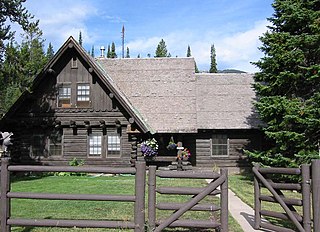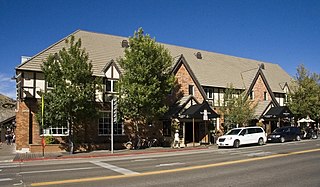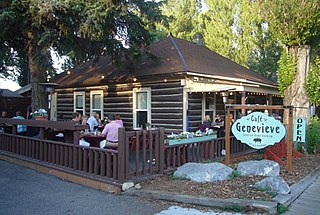
The Old Administrative Area Historic District, also known as Beaver Creek, is the former headquarters area of Grand Teton National Park. The complex of five houses, three warehouses and an administrative building were designed in the National Park Service rustic style between 1934 and 1939 and were built by the Civilian Conservation Corps and the Public Works Administration. As part of the Mission 66 program, the park headquarters were relocated to Moose, Wyoming in the 1960s.

The Cunningham Cabin is a double-pen log cabin in Grand Teton National Park. The cabin was built as a homestead in Jackson Hole and represents an adaptation of an Appalachian building form to the West. The cabin was built just south of Spread Creek by John Pierce Cunningham, who arrived in Jackson Hole in 1885 and subsisted as a trapper until he established the Bar Flying U Ranch in 1888. The Cunninghams left the valley for Idaho in 1928, when land was being acquired for the future Grand Teton National Park.

Mormon Row is a historic district in Teton County, Wyoming, United States that is listed on the National Register of Historic Places

The Andy Chambers Ranch a historic district in Teton County, Wyoming, United States, that is listed on the National Register of Historic Places.

The AMK Ranch is a former personal retreat on the eastern shore of Jackson Lake in Grand Teton National Park. Also known as the Merymare, Lonetree and Mae-Lou Ranch, it was a former homestead, expanded beginning in the 1920s by William Louis Johnson, then further developed in the 1930s by Alfred Berol (Berolzheimer). Johnson built a lodge, barn and boathouse in 1927, while Berol added a larger lodge, new boathouse, and cabins, all in the rustic style.

The Jackson Lake Ranger Station is the last Depression-era U.S. Forest Service ranger station in its original location in Grand Teton National Park. When first established, the park comprised only the mountainous terrain above Jackson Hole, while the remainder of what would eventually become the park was administered by the Forest Service as part of Teton National Forest. The Jackson Lake Station was built in 1933 as close as possible to Park Service property as possible as a kind of resistance to the park's expansion. The station was one of five Forest Service stations in the area, and was taken over by the National Park Service when Jackson Hole National Monument was established in 1943, later becoming an enlarged Grand Teton National Park. It is the only such station not to have been moved or altered by the Park Service.

The Church of St. Hubert the Hunter and its associated library, also known as the Bondurant Protestant Episcopal Church were built in Bondurant, Wyoming, the church in 1940-41 and the library in 1943. The church was financed by the sale of a diamond bequeathed to the Episcopal Church by Mrs. John Markoe, which was to be sold to finance a memorial church. According to some versions, the church was to be built in the most remote part of the United States. Wyoming Bishop Winfred H. Zeigler suggested Bondurant, where he had been forced to take shelter from a blizzard while traveling in 1937. The diamond was sold for $1400, and Zeigler returned to Bondurant to organize the construction of the church by local volunteers.

Flat Creek Ranch, formerly a working ranch in Jackson Hole, Wyoming, is a guest ranch. The original ranch was established by Cal Carrington between 1901 and 1918 at the base of Sheep Mountain, also known as the ″Sleeping Indian″. In 1923 a new owner, socialite and journalist Cissy Patterson, built the present structures. The transition from working ranch to vacation retreat foreshadowed a movement of the Jackson Hole economy away from traditional ranching to tourism, which is documented by the Flat Creek Ranch.

The Gap Puche Cabin is a log cabin near Jackson, Wyoming that is the last survivor of the early outfitting industry in Jackson Hole. It was built c. 1929 at the junction of the Gros Ventre River and Crystal Creek by brothers-in-law Actor Nelson and Charlie Smith. Beginning in 1930 the property was used by John Wort and Steve Callaghan as a base camp for their hunting guide, or outfitting operation, and became known as "Wort's Hunting Camp". Callaghan's interest in the operation was bought by Billy Stilson around 1935, and bought out Wort by 1939. The cabin was moved in 1942 or 1943 to its present location.

The Wort Hotel was built in downtown Jackson, Wyoming, United States by brothers John and Jess Wort, who were significant figures in the transformation of the economy of Jackson Hole from ranching to tourism. The somewhat Tudor-style building was the first luxury hotel in Jackson. The two-story building features brick facing, with half-timbering and stucco on the second floor and a series of gables facing the street.

The Miller Cabin complex consists of three buildings that were the residence of Robert A. Miller, the first superintendent of Teton National Monument. A house, a barn and a cabin built by the U.S. Forest Service are included. The property was eventually transferred to the U.S. Fish and Wildlife Service in what became the National Elk Refuge. The buildings are a component of the closely related Grace and Robert Miller Ranch.

The Manges Cabin in Grand Teton National Park, also known as the Old Elbo Ranch Homestead Cabin, Mangus Cabin and the Taggart Creek Barn, was built in 1911 by James Manges. Manges was the second settler on the west side of the Snake River after Bill Menor, setting up a homestead near Taggart Creek. James Manges arrived in Jackson Hole in 1910, where he cut wood for Charles or William Wort. Manges' cabin is stated to have been the first two-story structure in the northern part of the valley. A root cellar was excavated beneath. The log and frame structure features wide eaves to keep the winter snow away from the walls. It was heated in winter by a single stove, with one room on each level.

Leek's Lodge is part of a former resort and dude ranch in Grand Teton National Park, near Jackson Lake. The ranch was specifically intended to offer activities to boys in a frontier setting. Its founder, Steven N. Leek, was instrumental in the establishment of the National Elk Refuge in Jackson Hole. The rustic lodge was built in 1927.

The White Grass Dude Ranch is located in the White Grass Valley of Grand Teton National Park. The rustic log lodge, dining hall service building and ten cabins were built when a working ranch was converted to a dude ranch, and represented one of the first dude ranch operations in Jackson Hole. The White Grass was established in 1913 by Harold Hammond and George Tucker Bispham, who combined two adjacent ranches or 160 acres (65 ha) each, and was converted to a dude ranch in 1919. Bispham had worked at the Bar B C before moving out on his own. The dude ranch operation continued to 1985, when the ranch was acquired by the National Park Service.

The Jenny Lake Ranger Station Historic District comprises an area that was the main point of visitor contact in Grand Teton National Park from the 1930s to 1960. Located near Jenny Lake, the buildings are a mixture of purpose-built structures and existing buildings that were adapted for use by the National Park Service. The ranger station was built as a cabin by Lee Mangus north of Moose, Wyoming about 1925 and was moved and rebuilt around 1930 for Park Service use. A store was built by a concessioner, and comfort stations were built to Park Service standard plans. All buildings were planned to the prevailing National Park Service Rustic style, although the ranger station and the photo shop were built from parts of buildings located elsewhere in the park.

The Van Vleck House was built in Jackson, Wyoming in 1910-1011. The log house and barn are the only remaining residential structures in the vicinity of the Town Square.

The Grace and Robert Miller Ranch represents an expansion of the previously existing Miller Cabin listing on the National Register of Historic Places. The ranch was the home of Robert E. Miller, first superintendent of Jackson Hole National Monument. The property was transferred to the U.S. Fish and Wildlife Service as part of the National Elk Refuge.

The Geraldine Lucas–Fabian Place Historic District in Jackson Hole, Wyoming is significant as the 1913 home of Geraldine Lucas, a single woman pioneer in a harsh environment. It later became the home of Harold Fabian, vice president of the Snake River Land Company, which assembled much of the land that became Jackson Hole National Monument for John D. Rockefeller, Jr..

The historical buildings and structures of Grand Teton National Park include a variety of buildings and built remains that pre-date the establishment of Grand Teton National Park, together with facilities built by the National Park Service to serve park visitors. Many of these places and structures have been placed on the National Register of Historic Places. The pre-Park Service structures include homestead cabins from the earliest settlement of Jackson Hole, working ranches that once covered the valley floor, and dude ranches or guest ranches that catered to the tourist trade that grew up in the 1920s and 1930s, before the park was expanded to encompass nearly all of Jackson Hole. Many of these were incorporated into the park to serve as Park Service personnel housing, or were razed to restore the landscape to a natural appearance. Others continued to function as inholdings under a life estate in which their former owners could continue to use and occupy the property until their death. Other buildings, built in the mountains after the initial establishment of the park in 1929, or in the valley after the park was expanded in 1950, were built by the Park Service to serve park visitors, frequently employing the National Park Service Rustic style of design.

The American Legion Hall, Post 32 is a prominent social center in Greybull, Wyoming. Built in 1922 as a temporary church, it became an American Legion hall in 1935. Used as overflow space by nearby schools, it serves a diverse range of functions in the community.


















